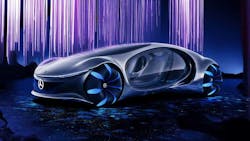“Avatar”-Inspired Concept Car Uses Brain Activity as UI
What you'll learn:
- How does Mercedes-Benz's brain-computer interface operate?
- In the concept car, the front and rear axles simultaneously or in opposite ways, enabling sideways movement by 30 degrees.
- The high-capacity battery enables extended range to 700+ km.
Mercedes-Benz demonstrated the first brain-computer interface (BCI) in its VISION AVTR concept vehicle at the IAA Mobility 2021 show that ran from September 7-12 in Munich. The name of the concept vehicle, which stands for Advanced Vehicle Transformation, enables a completely new interaction between man and machine in the autonomous-driving vehicle.
The company presented how BCI technology works and, for the first time, gave a preview of mind control as a new element of human interaction with a vehicle. “BCI technology has the potential to further enhance driving comfort in the future," said Britta Seeger, Member of the Board of Management of Daimler AG and Mercedes-Benz AG. "BCI technology works completely independently of speech and touch. This opens up revolutionary possibilities for intuitive interaction with the vehicle."
After a short calibration process, a BCI device attached to the user's head analyzes the measured brain waves and triggers a defined function. At the stand at the Munich fairgrounds, visitors experienced controlling the user interface in a seat mockup of the VISION AVTR, controlling vehicle functions with their own thoughts and interacting with it in real-time. The user just had to focus on a particular light on the car's digital display to select a function, which included choosing a particular parking space for the autonomous car to steer itself into.
How Does It Work?
With brain-computer-interface technology, light dots are projected onto a fully digital dashboard. A BCI device with wearable electrodes attached to the back of the user's head records brain activity and establishes a direct connection to the vehicle after a one-minute calibration. The brain reacts to the visual stimuli on the dashboard.
The BCI device measures the neuronal activity at the cortex in real-time. It analyzes the measured brain waves and recognizes which light points the user directs his focus and full attention (via an attention-sensing interface). The stronger the focus, the higher the neuronal activity. The device then triggers the targeted function in the vehicle.
Using several functions linked to BCI technology, visitors to the trade fair experienced how quickly their own brain connected with the vehicle—similar to the neuronal connection between the Na’vi characters and nature in the Hollywood blockbuster Avatar.
Instead of a conventional steering wheel, the VISION AVTR has a multifunctional control element in the center console. By placing a hand on the control, the interior comes to life and the vehicle recognizes the passenger by their heart rate.
Simply raising the hand projects a menu selection onto the palm of the hand, allowing the user to choose between different functionalities. There's no wheel, buttons, or dials inside the car, just smooth surfaces capable of acting as a display. Interacting with the car's systems is achieved through the BCI.
Other Features
With four near-wheel-built electric motors, the VISION AVTR has a combined engine power of more than 350 kW. Thanks to what Mercedes describes as “intelligent and fully variable torque distribution,” each wheel can be driven separately depending on the driving situation. Due to the possibility of driving the front and rear axles simultaneously or in opposite ways, the VISION AVTR can move sideways by approximately 30 degrees—unlike conventional vehicles—in a so-called “crab movement.”
The VISION AVTR employs a compact, high-voltage battery. For the first time, the battery technology is based on graphene-based organic cell chemistry and thus eliminates toxic and expensive rare-earth materials. Electromobility becomes independent of fossil resources. The concept vehicle also features 100% recyclability via composting.
With a capacity of around 110 kWh, the VISION AVTR enables an electric range of more than 700 km. By recuperating energy during roll-out and braking, the high-voltage battery can be recharged with a higher efficiency than current systems while driving. This contributes to the high energy efficiency of the overall system.
In addition to a high energy density—compared to today’s battery systems with up to 1,200 Wh/liter—the technology has fast charging capability via automated, conductive charging. This means that the battery will be fully recharged in less than 15 minutes.


